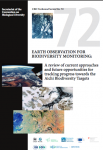The Secretariat of the Convention on Biological Diversity (CBD) has published a technical study, which shows how earth observation technologies can and should fit into systems for biodiversity monitoring.
The report is intended as a resource for earth observation specialists, biodiversity scientists and policy makers, and aims at creating common ground and initiating further dialogue.
 April 2014: The Secretariat of the Convention on Biological Diversity (CBD) has published a technical study that shows how Earth observation technologies can and should fit into systems for biodiversity monitoring. The report is intended as a resource for Earth observation specialists, biodiversity scientists and policy makers, and aims at creating common ground and initiating further dialogue.
April 2014: The Secretariat of the Convention on Biological Diversity (CBD) has published a technical study that shows how Earth observation technologies can and should fit into systems for biodiversity monitoring. The report is intended as a resource for Earth observation specialists, biodiversity scientists and policy makers, and aims at creating common ground and initiating further dialogue.
Titled ‘Earth Observation for Biodiversity Monitoring: A review of current approaches and future opportunities for tracking progress towards the Aichi Biodiversity Targets’ and authored by Cristina Secades, Brian O’Connor, Claire Brown and Matt Walpol from the UN Environment Programme World Conservation Monitoring Centre (UNEP-WCMC), together with a wide range of contributors, the report was published as CBD Technical Series No. 72. It offers an overview of the possibilities that remotely sensed data provide to biodiversity monitoring in the context of the Aichi Targets. Focusing particularly on space-borne (satellite) sensors whilst also considering airborne and ground-based systems, it explores the obstacles and opportunities for greater use of remotely sensed data. Its intention is to bridge the gap between the earth observation and biodiversity decision-making communities, enabling productive dialogue through a shared understanding of needs and opportunities.
The report is structured in three main sections. The first section describes operational earth observation data products as well as those under research and development on a Target by Target basis, and discusses some of their current applications and limitations. The second section discusses national-level case studies where earth observation data have been applied, illustrating the value of open access data, and resource and capacity constraints. The third section describes the limitations and key challenges that have prevented the update of earth observation data for indicator development more broadly, and discusses the way forward.
Among its key messages, the report concludes that the potential for remotely sensed earth observation data to support biodiversity policy is growing, but is yet to be fully realized. There are clear opportunities presented by existing and emerging remote sensing capabilities to support monitoring of the Aichi Targets; however, the use of remotely sensed earth observation data is often constrained by access to data and processing capacity. Creating a dialogue between data providers and users is considered critical to realizing the potential of remotely sensed data. [Publication: CBD Technical Series No. 72: Earth Observation for Biodiversity Monitoring: A review of current approaches and future opportunities for tracking progress towards the Aichi Biodiversity Targets]